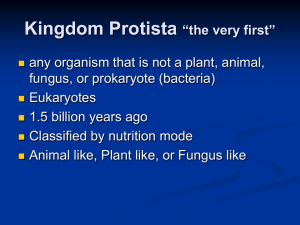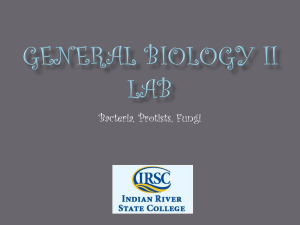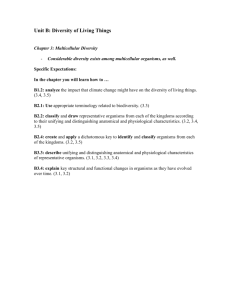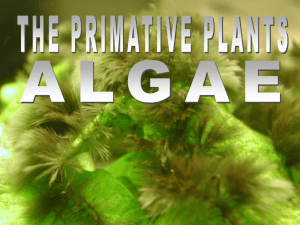Topic 2: Protists (Ch. 28)
advertisement
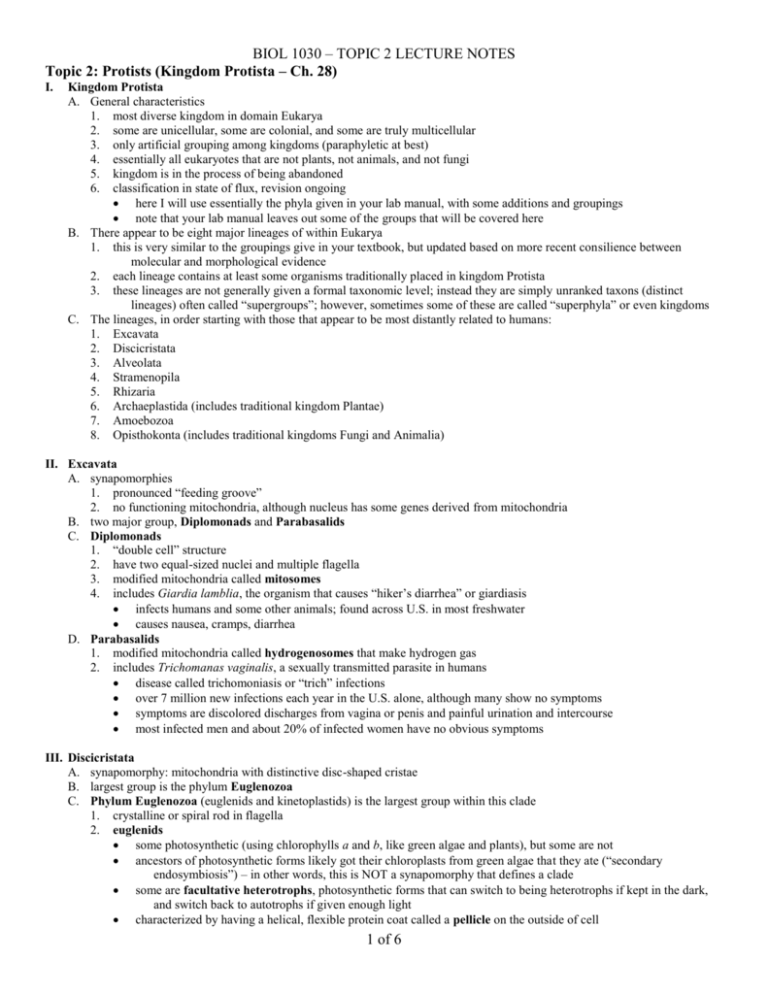
BIOL 1030 – TOPIC 2 LECTURE NOTES Topic 2: Protists (Kingdom Protista – Ch. 28) I. Kingdom Protista A. General characteristics 1. most diverse kingdom in domain Eukarya 2. some are unicellular, some are colonial, and some are truly multicellular 3. only artificial grouping among kingdoms (paraphyletic at best) 4. essentially all eukaryotes that are not plants, not animals, and not fungi 5. kingdom is in the process of being abandoned 6. classification in state of flux, revision ongoing here I will use essentially the phyla given in your lab manual, with some additions and groupings note that your lab manual leaves out some of the groups that will be covered here B. There appear to be eight major lineages of within Eukarya 1. this is very similar to the groupings give in your textbook, but updated based on more recent consilience between molecular and morphological evidence 2. each lineage contains at least some organisms traditionally placed in kingdom Protista 3. these lineages are not generally given a formal taxonomic level; instead they are simply unranked taxons (distinct lineages) often called “supergroups”; however, sometimes some of these are called “superphyla” or even kingdoms C. The lineages, in order starting with those that appear to be most distantly related to humans: 1. Excavata 2. Discicristata 3. Alveolata 4. Stramenopila 5. Rhizaria 6. Archaeplastida (includes traditional kingdom Plantae) 7. Amoebozoa 8. Opisthokonta (includes traditional kingdoms Fungi and Animalia) II. Excavata A. synapomorphies 1. pronounced “feeding groove” 2. no functioning mitochondria, although nucleus has some genes derived from mitochondria B. two major group, Diplomonads and Parabasalids C. Diplomonads 1. “double cell” structure 2. have two equal-sized nuclei and multiple flagella 3. modified mitochondria called mitosomes 4. includes Giardia lamblia, the organism that causes “hiker’s diarrhea” or giardiasis infects humans and some other animals; found across U.S. in most freshwater causes nausea, cramps, diarrhea D. Parabasalids 1. modified mitochondria called hydrogenosomes that make hydrogen gas 2. includes Trichomanas vaginalis, a sexually transmitted parasite in humans disease called trichomoniasis or “trich” infections over 7 million new infections each year in the U.S. alone, although many show no symptoms symptoms are discolored discharges from vagina or penis and painful urination and intercourse most infected men and about 20% of infected women have no obvious symptoms III. Discicristata A. synapomorphy: mitochondria with distinctive disc-shaped cristae B. largest group is the phylum Euglenozoa C. Phylum Euglenozoa (euglenids and kinetoplastids) is the largest group within this clade 1. crystalline or spiral rod in flagella 2. euglenids some photosynthetic (using chlorophylls a and b, like green algae and plants), but some are not ancestors of photosynthetic forms likely got their chloroplasts from green algae that they ate (“secondary endosymbiosis”) – in other words, this is NOT a synapomorphy that defines a clade some are facultative heterotrophs, photosynthetic forms that can switch to being heterotrophs if kept in the dark, and switch back to autotrophs if given enough light characterized by having a helical, flexible protein coat called a pellicle on the outside of cell 1 of 6 BIOL 1030 – TOPIC 2 LECTURE NOTES 3. only asexual reproduction important members of many freshwater food chains example: Euglena. kinetoplastids single, large mitochondrion that has an organized mass of DNA called a kinetoplast include trypanosomes – a group that includes some important parasites of humans and domestic animals African sleeping sickness: caused by Trypanosoma i. carried to new host by biting fly (tsetse fly) ii. Affects cattle and prevents livestock culture in large area of Africa. Leishmaniasis (caused by Leishmania) i. carried to new host by biting fly (sand fly) in tropical areas ii. causes sores and erosion of skin (4 million people/yr) IV. Alveolata A. synapomorphy: sac-like “alveoli” that form a continuous layer just under the plasma membrane B. 3 major groups 1. Phylum Dinoflagellata (dinoflagellates) 2. Phylum Apicomplexa (sporozoans) 3. Phylum Ciliophora (ciliates) C. Phylum Dinoflagellata (dinoflagellates) 1. unicellular, mostly marine; 2100 species known 2. usually have 2 flagella 3. most have chlorophylls a and c, so chloroplasts are like those of diatoms, golden algae, and brown algae, more likely due to secondary endosymbiosis 4. have an exoskeleton made up of plates of cellulose 5. reproduce mostly by asexual reproduction (sex rare but it does occur) 6. important/interesting roles: zooxanthellae: symbionts (live in mutually beneficial relationship) in other organisms (jellyfish, sea anemones, mollusks, corals) zooxanthellae in corals (up to 30,000 cells per cubic mm or coral tissue) do photosynthesis and make carbon products absorbed by coral help make coral reefs one of most productive habitats on Earth can actually leave the corals and live on their own – probably in response to pollution many of the world’s coral reefs are bleaching (dinoflagellates are leaving), killing the coral bioluminescent: many planktonic dinoflagellates emit light when disturbed creates sparkling waves and glowing wakes of ships at night Why do this? Perhaps to attract predatory fish to eat the predators of the dinoflagellates! predatory dinoflagellates some generate toxins that they use to kill marine life example, Pfiesteria piscicida: stuns fish with toxin and feeds on body fluids red tides: population explosions (“blooms”) that can color the water with pigmented dinoflagellate cells; red tides kill marine life due to the high concentration of toxins from the dinoflagellates some dinoflagellates cause disease in humans who are exposed to them in high levels hog farm manure lagoons in NC appear to be a breeding ground for deadly dinoflagellates that cause freshwater fish kills and human disease D. Phylum Apicomplexa (sporozoans) 1. unicellular 2. nonmotile, spore-forming parasites of animals (their spores are infective bodies used to reach new hosts) 3. ~3900 species described 4. cell structure unique: one end (apex) of cell has dense concentration of organelles 5. complex life cycle, with both sexual and asexual phases – alternation of generations 6. famous example: Plasmodium cause of malaria complex life cycle: uses mosquito and human as host one of most serious diseases worldwide: 500 million cases/yr (2 million deaths) attacked by mosquito control (often insecticides) and antimalarial drugs problem: both mosquitoes and Plasmodium evolve resistance to control chemicals, and control chemicals can be harmful (read Rachel Carson’s Silent Spring) Maybe develop vaccine? 2 of 6 BIOL 1030 – TOPIC 2 LECTURE NOTES E. Phylum Ciliophora (ciliates) 1. unicellular (but some big and internally complex) 2. ~8000 species known 3. most with many cilia 4. outer covering (called pellicle) of tough protein material 5. form vacuoles for ingesting food and regulating water balance 6. two types of nuclei: macronucleus (large) and micronucleus (small) micronuclei – diploid chromosomes – for sexual reproduction macronuclei – derived from micronuclei; multiple copies of small strands of DNA (sometimes one gene) for metabolic, synthetic, and developmental functions 7. unusual sexual reproduction: conjugation – two different mating types; partners exchange haploid micronuclei that can will then fuse to make diploid micronuclei 8. famous example: Paramecium V. Stramenopila A. synapomorphy: normally two flagella when present, with hairlike projections on one of them B. 4 major groups 1. Phylum Oomycota (oomycetes) 2. Phylum Bacillariophyta (diatoms) 3. Phylum Chrysophyta (golden algae) 4. Phylum Phaeophyta (brown algae) C. Phylum Oomycota (oomycetes – water molds, rusts, and downy mildews) 1. ~580 species 2. parasites or saprobes (feed on dead organic matter) 3. cellulose or cellulose-like cell wall (no chitin) 4. can form filamentous structures (threadlike cells) called hyphae 5. asexual and sexual reproduction sexual via gametic meiosis; zygote becomes thick-walled oospore make asexual spores called mitospores by mitosis as with all spores, one can form a new organism without joining with another cell swimming mitospores are called a zoospores zoospores have two unequal flagella pointing in opposite directions 6. importance: some cause diseases of plants or fish, such as potato blight and downy mildew example, late blight of potato (Phytophthora), cause of Irish Potato Famine Irish peasants depended on potatoes as staple food 1845-1847, late blight of potato struck; destroyed crops 1 million Irish starved to death, 1 million emigrated (many to U.S.) D. Phylum Bacillariophyta (diatoms) 1. have chlorophylls a and c, so chloroplasts are like those of golden algae and brown algae 2. make chrysolaminarin, a unique carbohydrate used for energy storage (also made by golden algae) 3. unicellular 4. more than 11,500 living species known 5. occur in plankton 6. lack flagella 7. have a cell wall made up of double shells of silica that fit together like a box and lid 8. diatom shells have intricate designs 9. mostly asexual reproduction, but can undergo gametic meiosis (diatoms are usually diploid for most of their life cycle) 10. importance: “grass of the sea” – abundant members of plankton; perform a large % of the photosynthesis done in oceans fossil deposits of cell walls called “diatomaceous earth”, which is mined and used for pest control (applied to insects, gets in appendages and grinds them to death), reflective paints, filters E. Phylum Chrysophyta (golden algae) 1. have chlorophylls a and c, so chloroplasts are like those of diatoms and brown algae 2. make chrysolaminarin 3. unicellular but often colonial 4. freshwater protists 5. have yellow and brown carotenoid and xanthophyll accessory pigments, giving them a golden color 6. typically have two flagella 3 of 6 BIOL 1030 – TOPIC 2 LECTURE NOTES F. 7. can form cysts resistant to desiccation Phylum Phaeophyta (brown algae) 1. ~1500 species, 2. all multicellular, often large, including kelps 3. chloroplasts have chlorophylls a and c (like diatoms, golden algae, and dinoflagellates) 4. make laminarin, a unique carbohydrate used for energy storage (similar to chrysolaminarin) 5. usually sexual reproduction w/ alternation of generations and sporic meiosis 6. focus on kelps: often have a complex, branching vascular system analogous to plants form “kelp forests” that are important shallow-water habitats example: Sargasso weed Sargassum, the primary producer in the Sargasso Sea kelps also harvested for cell wall materials called alginates, used as thickeners in foods and other products VI. Rhizaria A. synapomorphies 1. produce elaborate shell-like coverings of cells 2. use very slender pseudopodia to move B. 2 major groups 1. Phylum Foraminifera (forams) 2. Phylum Radiolaria (radiolarians) C. Phylum Foraminifera (forams) 1. unicellular 2. marine group: some are plankton, most live attached to bottom or other organisms 3. make skeleton (called test) of organic material plus sand, calcium carbonate 4. podia (thin cytoplasmic projections) used for swimming, feeding 5. complex life cycle: alternation of generations with sporic meiosis (haploid and diploid generations formed) 6. important fossil group (200 million years of geological record); tests tend to last 7. limestone rocks are often rich in forams (example: the white cliffs of Dover, England) D. Phylum Radiolaria (radiolarians) 1. unicellular 2. have glassy shells (external skeletons) made of silica 3. exoskeleton gives fixed shape, with bilateral or radial symmetry 4. use needle-like pseudopodia for locomotion 5. marine group: part of plankton (microscopic floating marine organisms) 6. valuable fossils for geological record – shells tend to last VII. Archaeplastida A. synapomorphy: primary endosymbiosis – chloroplasts with a double membrane, derived from an ancestor directly engulfing a cyanobacterium B. 3 major groups 1. Phylum Rhodophyta (red algae) 2. Phylum Chlorophyta (green algae) 3. Kingdom Plantae (plants) – not protists, covered later in this course! 4. Chlorophyta and Plantae are combined by many into the kingdom Viridiplantae C. Phylum Rhodophyta (red algae) 1. estimated 4000+ species; mostly marine and mostly multicellular 2. no flagella 3. chloroplasts have phycobilins and chlorophyll a characteristic of cyanobacteria, which appear to have been the first photosynthetic organisms thus the chloroplasts of red algae seem to be derived from an endosymbiotic relationship with cyanobacteria 4. red color comes from a type of phycobilin (absorbs violet, blue, and green light; reflects red) 5. able to photosynthesize at significant depths 6. usually have sexual reproduction w/ alternation of generations and sporic meiosis 7. importance: coral reefs: partially made of coralline red algae, which have calcium carbonate forming part of their cell walls agar and carrageenan – cell wall components extracted from some red algae that are used as emulsifiers and thickeners (ice cream, cosmetics, paints, jellies, laboratory medium, etc.) D. Phylum Chlorophyta (green algae) 1. 7000+ species 4 of 6 BIOL 1030 – TOPIC 2 LECTURE NOTES 2. 3. 4. 5. 6. 7. 8. diverse (mostly aquatic, both marine and freshwater species; some semi-terrestrial) full range from unicellular to colonial to multicellular species chlorophyll a and b (like plants) some symbionts (example: lichens with fungi) asexual reproduction as well as alternation of generations with sporic meiosis importance: major producers in aquatic ecosystems (base of food chains) possible human/animal nutritional supplement evolutionary importance – plants (Kingdom Plantae) apparently evolved from a line of green algae biochemically similar chloroplasts between green algae and plants, with chlorophyll a and b and carotenoids multicellular forms similar to nonvascular plants DNA sequencing supports clade of plants and green algae To be seen in lab: unicellular motile example: Chlamydomonas note zygotic meiosis and asexual reproduction in haploid phase motile (swimming) colonial example: Volvox note daughter colonies (made asexually inside main sphere) parenchymatous (3-D body) form: Ulva (sea lettuce) note life cycle is sporic meiosis where gametophyte and sporophyte look identical (isomorphic alternation of generations) VIII. Amoebozoa A. synapomorphy: move using relatively large lobe-shaped pseudopodia B. 4 major groups 1. Phylum Gymnamoeba (free-living amoebas) 2. Phylum Entamoeba (parasitic amoebas) 3. Phylum Acrasiomycota (cellular slime molds) 4. Phylum Myxomycota (plasmodial slime molds) C. Phylum Gymnamoeba (free-living amoebas) 1. unicellular 2. amorphous (change shape readily) 3. move by pseudopodia or “false feet” (temporary, flowing extensions of cytoplasm) 4. lack sexual reproduction, cell walls, flagella 5. only asexual reproduction – fission after mitosis into two cells of equal volume 6. hundreds of species in a variety of environments: freshwater, marine, soil 7. many form cysts to resist harsh environmental conditions 8. many are predators, feeding on bacteria and other protists (use pseudopodia to engulf other cells) 9. some feed on detritus (nonliving organic matter) D. Phylum Entamoeba (parasitic amoebas) 1. similar to free-living amoebas, but are parasites of animals (feed on host tissues or cells but usually don’t kill host) 2. example: Entamoeba histolytica (cause of amoebic dysentery; kills about 100,000 people each year) 3. up to 10 million Americans may be infected by parasitic amoebas E. Phylum Acrasiomycota (cellular slime molds) 1. ~70 weird species 2. found in fresh water and on rotting vegetation 3. life cycle: free-living amoebas lack of food – aggregation into multicellular "slug" slug migrates toward light, then becomes sessile sorocarp sexual reproduction in sorocarp forms macrocysts with diploid nuclei that undergo zygotic meiosis 4. important lab organism: Dictyostelium discoideum – used to study development in multicellular organisms F. Phylum Myxomycota (plasmodial slime molds) 1. also called phylum Myxogastrida (this is what is used in your lab manual) 2. ~500 weird species 3. feeding phase is plasmodium, a nonwalled, multinucleated mass 4. plasmodium has conspicuous cytoplasmic streaming 5. essentially an "organic ooze" the flows around and ingests organic matter 6. can make diploid or haploid spores that are like cysts 7. when food is in short supply, form a spore-containing structure often called a sporangium 5 of 6 BIOL 1030 – TOPIC 2 LECTURE NOTES “angios” from Greek for “vessel” plural is sporangia IX. Opisthokonta A. synapomorphies 1. when present, single flagellum at base of reproductive cells 2. flat cristae inside mitochondria B. includes traditional kingdoms Fungi and Animalia C. also includes several protist groups, most notably the choanoflagellates 1. choanoflagellates are the closest relatives to animals, and animals appear to have evolved from a choanoflagellate ancestor 2. more on choanoflagellates when animals are covered later in the course 6 of 6


